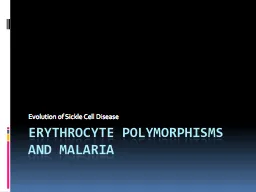

Evolution of Sickle Cell Disease 10 year old Haitian girl Goes to clinic with severe chest pain Many visits for joint pains amp exhaustion Labeled a hypochondriac Blood count revealed low ID: 581762
Download Presentation The PPT/PDF document "Erythrocyte Polymorphisms and malaria" is the property of its rightful owner. Permission is granted to download and print the materials on this web site for personal, non-commercial use only, and to display it on your personal computer provided you do not modify the materials and that you retain all copyright notices contained in the materials. By downloading content from our website, you accept the terms of this agreement.
Slide1
Erythrocyte Polymorphisms and malaria
Evolution of Sickle Cell Disease Slide2
10 year old Haitian girl
Goes to clinic with severe chest pain
Many visits for joint pains & exhaustion
Labeled a hypochondriacBlood count revealed low rbcsSlide3
Blood smearSlide4
Sickle Cell Disease
70 million Americans have Sickle Cell Disease
2 million are carriers of Sickle Cell Trait
Most have SubSaharan African Ancestry1 in 12 African Americans has Sickle Cell TraitSlide5
Sickle Cell Disease
Catastrophic disease of children
Attacks occur when oxygen levels in blood drop
Red blood cells deform & assume sickle shapeSickle cells tend to trap other blood cells, cause “sludging”.Severe
sludging
deprives tissues of oxygen and can kill muscle and bone.Slide6
Sickle cell disease – Why?
Proximate hypothesis?
Ultimate hypothesis?Slide7
HemoglobinSlide8
Hemoglobin
Oxygen transport –
Picks up oxygen from the pulmonary veins – drops off oxygen in tissues and capillary beds
Contains ironRed blood cellsSlide9
Mutation of Beta HemoglobinSlide10
Blockage of circulationSlide11
Human Variation
HbAA
– homozygote “normal hemoglobin”
HbAS – heterozygote sickle cell traitHbSS – homozygote sickle cellSlide12
Inheritance
Sickle Cell is
inheritence
is autosomal recessiveHb AAHb AS – usually no symptoms
Hb
SS – manifests as sickle cell diseaseSlide13
Sickle Cell Disease
High Mortality:
Males with
HbSS Age 42 yearsFemales with HbSS Age 48 yearsAnemiaChest Pain
Stroke
Susceptibility to Bacterial InfectionsSlide14
GeographySlide15
Geography
SCD occurs in places with malaria
First described in southern Italy
Then noticed in subsaharan AfricaSickle cell trait absent in places like Kenyan highlands where mosquito and malaria absentSlide16
Balanced Polymorphism
Hb
AS – Benefit in Malaria?
Heterozygous
advantage
.
In Malarial regions:
HB AS better survival than HB AA or HB SS.Slide17
Another Case
January 2006, a US family
of 5
kids visit NigeriaPre-trip: pediatrician gives antidiarrheals
only
No chemoprophylaxis
3 kids all given
Fansidar
for
fever during trip.
Kids felt betterSlide18
3 had return of fever in US
Diagnosed with flu
Given antibiotics at the local clinic
Then they got sickerMom notices 1 child is very weak and has yellow eyes!Slide19
Yellow Kid
Yellow pupils
Anemic
Low Blood Sugar
1 in 20
rbcs
parasitized
Placed on Ventilator
Transfused
All 5 kids tested pos for
falciparum
malariaSlide20
Malaria
400 million cases worldwide
Malaria
kills 1,500,000 yearlyYoung children and pregnant womenImmunity
partial,
not durable
30,000 travelers: preventable
illnessSlide21
Malaria Vector & Pathogen
Female Anopheles - Crepuscular hours.
Congenital and transfusion - related cases
Autochthonous: single mosquito transmits disease from 1 human to anotherSlide22
Slide23
Slide24
Slide25
Slide26
Slide27
Severe Malaria
Cerebral
malaria
: seizures, comaSevere anemia, red cells burstHemoglobin in urine Fluid in lungs
Loss of platelets
Cardiovascular collapse and
shock
Blood becomes acidic Slide28
Malaria Pathogenesis
Malaria parasites digest RBC proteins and use glucose to lactic acid as energy, thus hypoglycemia & acidosis.
Injure RBC membrane:
hemolysis, splenic clearance & anemia.Makes blood cells sticky - obstruct microcirculation
Low platelets
-
splenic
sequestrationSlide29
HbSS
Full blown sickle cell disease
Increased mortality from sickle cell attacks.
In locations like Chicago, with no malaria, this genetic polymorphism would be subject to negative selection.What about in coastal Kenya?Slide30
HbAS
Admitted to hospital less in
malarious
regionsDie less often than HbAA in malarious regionsProtect against severe malaria infection
Infected
rbcs
sickle 40 times more readily than non infected cells
Decreased parasite reproduction
Increased clearance from the population.Slide31
Selection for HbAS
Outweighs negative selection for
HbSS
Maintains HbS allele in populationFrequency of allele is dependent on presence of malaria
Balanced polymorphismSlide32
So how does
HbAS
protect against malaria?
Evolutionary hypothesis can lead to insights into the proximate mechanisms of disease.Physiology and pathophysiology intersect…Slide33
Malaria: Sickle trait promotes removal of parasites!
HbSS
without malaria:
Cells sickle – cause obstruction of microcirculationAnemia - Sickled cells have enhanced removal from circulation
Increased
phagocytosis
Increased oxidative stress on
rbc
membrane
Sequestration of abnormal
rbcs
HbAS
and Malaria:
Cells sickle – cause obstruction of microcirculation
Anemia -
Sickled
cells have enhanced removal from circulation
Increased
phagocytosis
Increased oxidative stress on
rbc
membrane
Sequestration of abnormal
rbcsSlide34
Other polymorphisms that may protect against malariaSlide35
Language
Compare:
Red blood cell
defects and malaria Mol Biochem
Parasitol
. 2006 Oct;149(2):121-7.
Epub
2006 Jun 9
Erythrocyte
variants
and the nature of their malaria
protective
effect
Cellular Microbiology 7 (6): 753-763 2005
Host defenses or pathogen virulence factors?Slide36
Genes that cause disease
If they are common, they probably have some current or historical selective pressure that keeps them around
Deleterious mutations occur at rates 1:50,000
Some genes are very frequent e.g. 20% of population or more: raise questionsSlide37
Summary
Malaria – sickle cell trait is a balanced polymorphism
Genetic polymorphisms ask evolutionary question – what selective pressure or benefit keeps them in population
Frequency of polymorphism is a clue